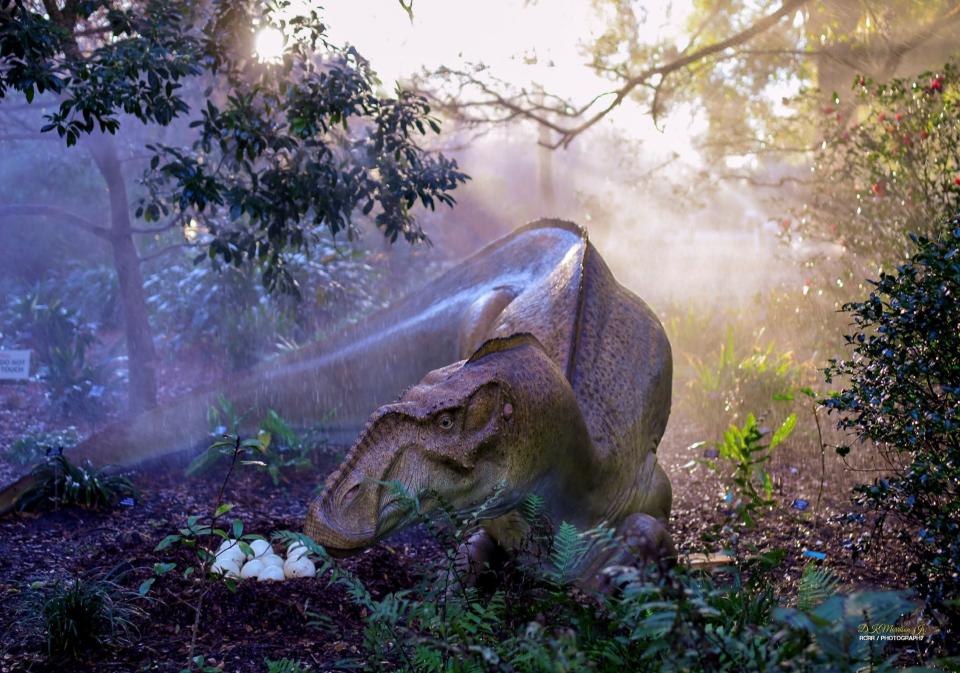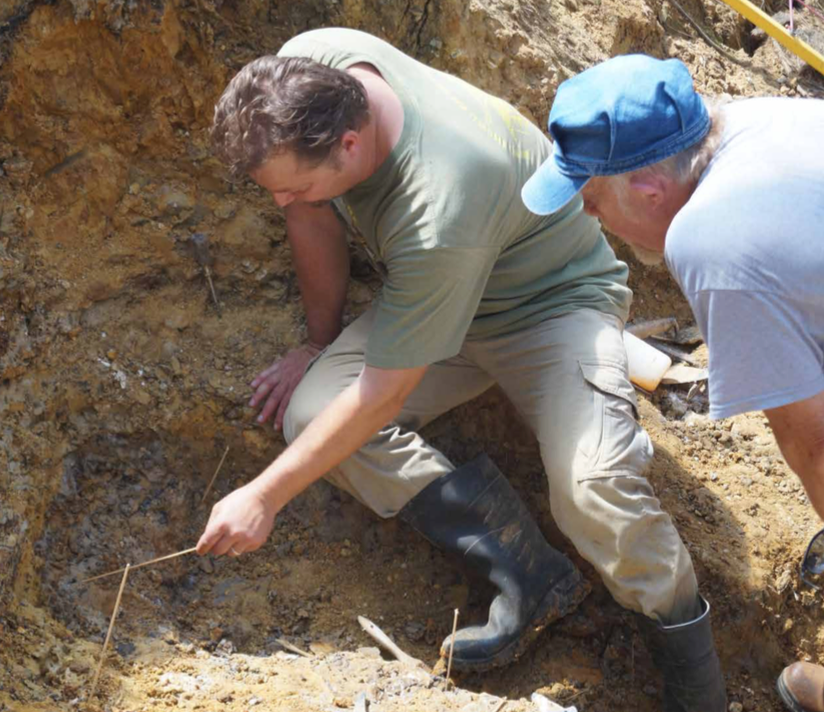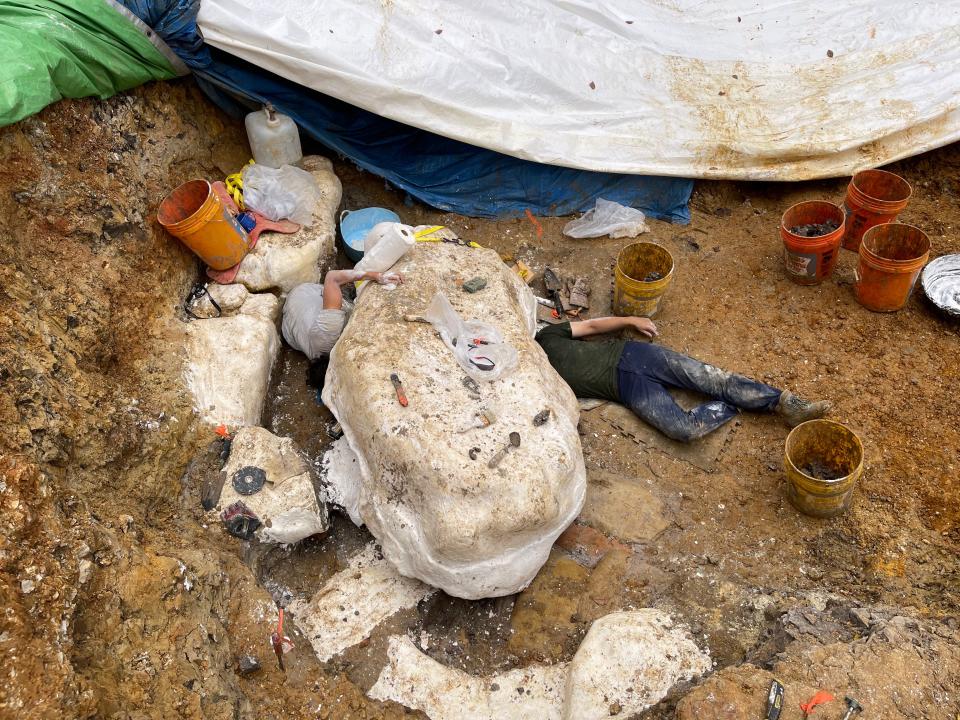Show-Me-a-saurus! Skeleton of a new type of dinosaur unearthed in Missouri
Scientists have identified not only the bones of a new dinosaur in southern Missouri, but also may have found a dinosaur hotbed.
The newly identified duck-billed dinosaur, named Parrosaurus missouriensis, grew to about 35 feet in length as an adult. Various dinosaur bones have been found at the dig site over the last eight decades, but now enough have been collected to make certain that a new genus and species had been discovered.
Just more than a month ago, researchers removed the dinosaur's body. "It was enormous, almost the size of a Volkswagen," said Guy Darrough, curator of the Sainte Genevieve Museum Learning Center in Ste. Genevieve, Missouri.
The discovery is like "hitting King Tut's tomb," said Darrough, who first began working at the site four decades ago. "I can't think of another discovery that would be bigger than dinosaurs in Missouri."
The finding also adds to scientists' knowledge of the ecology of the Western Interior Seaway, a body of water that divided North America more than 70 million years ago. While the majority of dinosaur finds have been in western states, this site in southern Missouri – it would have been on the seaway's eastern shore – has been yielding finds for decades.
New COVID variant: Dubbed 'omicron' by WHO, classified as 'variant of concern'
Water issues: Montana compact preserving forest rivers faces tests: growth, climate

About 80 years ago at the site, scientists found the first dinosaur bones there; they were suspected to be the remains of a large sauropod, a plant-eating dinosaur, Darrough said. Charles Gilmore, a paleontologist at the Smithsonian National Museum of Natural History, looked at the bones and, along with Dan Stewart of the Missouri Geological Survey, wrote a paper on the dinosaur, which became known as Parrorsaurus missouriensis, according to the Bollinger County (Mo.) Museum of Natural History.
Another cache of bones – a skeleton of what they learned was a juvenile dinosaur and a dinosaur jaw with teeth – was found in the 1980s, after geologist Bruce Stinchcomb bought the property. Those bones suggested the dinosaur was not a sauropod but actually a hadrosaur, or duck-billed dinosaur.
Hadrosaurs have long been considered herbivores, but some findings in recent years suggest they might have eaten crustaceans, either opportunistically or accidentally.
Video: Frankie the Dinosaur stars in United Nations PSA
Scientists had thought the dinosaur looked like the brontosaurus used in the Sinclair Oil advertising, "but it turns out it's a totally different type of dinosaur," Darrough said.
A fossil collector, Darrough asked if he could set up a greenhouse to dig there at the site and successfully found some dinosaur bones. Also found: the tooth of a dinosaur that is a relative to Tyrannosaurus rex.
Darrough contacted Peter Makovicky, a paleontologist who then was curator of dinosaurs at The Field Museum in Chicago. He traveled to Missouri in 2016 and soon had a dig team sent to the site.
"Most people thought we were finding mastodons and mammoths," Darrough said. "Those big animals are like, you know, 10,000 years old. But dinosaurs are like 70 million (years o). I knew they were dinosaur bones, but I just kept quiet."
Darrough was "a very serious fossil collector and actually knew his stuff," Makovicky said, but admitted to being "guarded, but very intrigued" about the find prior to arriving.

The site was "at the bottom of a glen in the Ozarks" and looked "like a frog pond," Makovicky said. "This didn't look like a dinosaur site. There was no exposed bedrock."
But they began finding bones including the tail, two arms and skull of a dinosaur that would have been around 35 feet long, Darrough said. And a little more than a month ago, they removed the body of that dinosaur. "It was enormous, almost the size of a Volkswagen," he said.
"It weighed over 2,000 pounds," said Makovicky, now a professor of earth and environmental sciences at the University of Minnesota.

For perspective, the Tyrannosaurus rex was thought to be about 40 feet long and 12 feet tall, while the Supersaurus dinosaur, revealed earlier this month, is thought to be the longest dinosaur at between 128 and 137 feet.
Based on the findings of the skull, arms and tail section, Makovicky concluded the bones were those of a duck-billed dinosaur and, since the original dinosaur name applied to the site, has been christened Parrorsaurus missouriensis. The dinosaur had already been named the state dinosaur of the state of Missouri, based on the previous findings.
There site will likely yield remains of at least four different Parrosaurus missouriensis dinosaurs, Makovicky said.
"Potentially there's a lot more here," he said. "We're actually looking at something that might be a mass death occurrence, like an entire herd that perished and washed into this waterhole or lagoon."
Speaking of death at the dig site, continuing research resulted in the finding of the "bony armor from a giant crocodile," a crocodilian, said Darrough, whose Lost World Studios creates life-sized dinosaur models for museums and botanical gardens.

"These things are like 50 feet long and they're big enough to take down a dinosaur. So when the Parrosaurus herds would be coming down to take a drink, these guys could snag them around the neck and pull them into the water and drown them. When you get a crocodile big enough to take down a dinosaur that is a big crocodile."
Regardless of what else is found, the Missouri dig has been a great example of scientific collaboration between paleontologists and "dedicated and generous local volunteers, who essentially started this project over 30 years ago," Makovicky said.
And it has helped expand the knowledge of dinosaurs in the U.S. east of the Western Interior Seaway, which at one point spread to the Appalachian Mountains.
"Most of the dinosaurs that every 6-year-old is familiar with, Tyrannosaurs, your various horned dinosaurs and duck-bills, and so on, were living west of the Seaway," Makovicky said. "From the eastern seaboard and the Midwestern states, we have far, far less knowledge of dinosaurs. So when you actually find a site where you have not just scraps, but multiple skeletons together, that's a real windfall."
Follow Mike Snider on Twitter: @mikesnider.
This article originally appeared on USA TODAY: Dinosaur bones in Missouri unearthed, reveal new duck-billed species

